engine coolant CHEVROLET TRACKER 1998 1.G User Guide
[x] Cancel search | Manufacturer: CHEVROLET, Model Year: 1998, Model line: TRACKER, Model: CHEVROLET TRACKER 1998 1.GPages: 386, PDF Size: 21.17 MB
Page 222 of 386
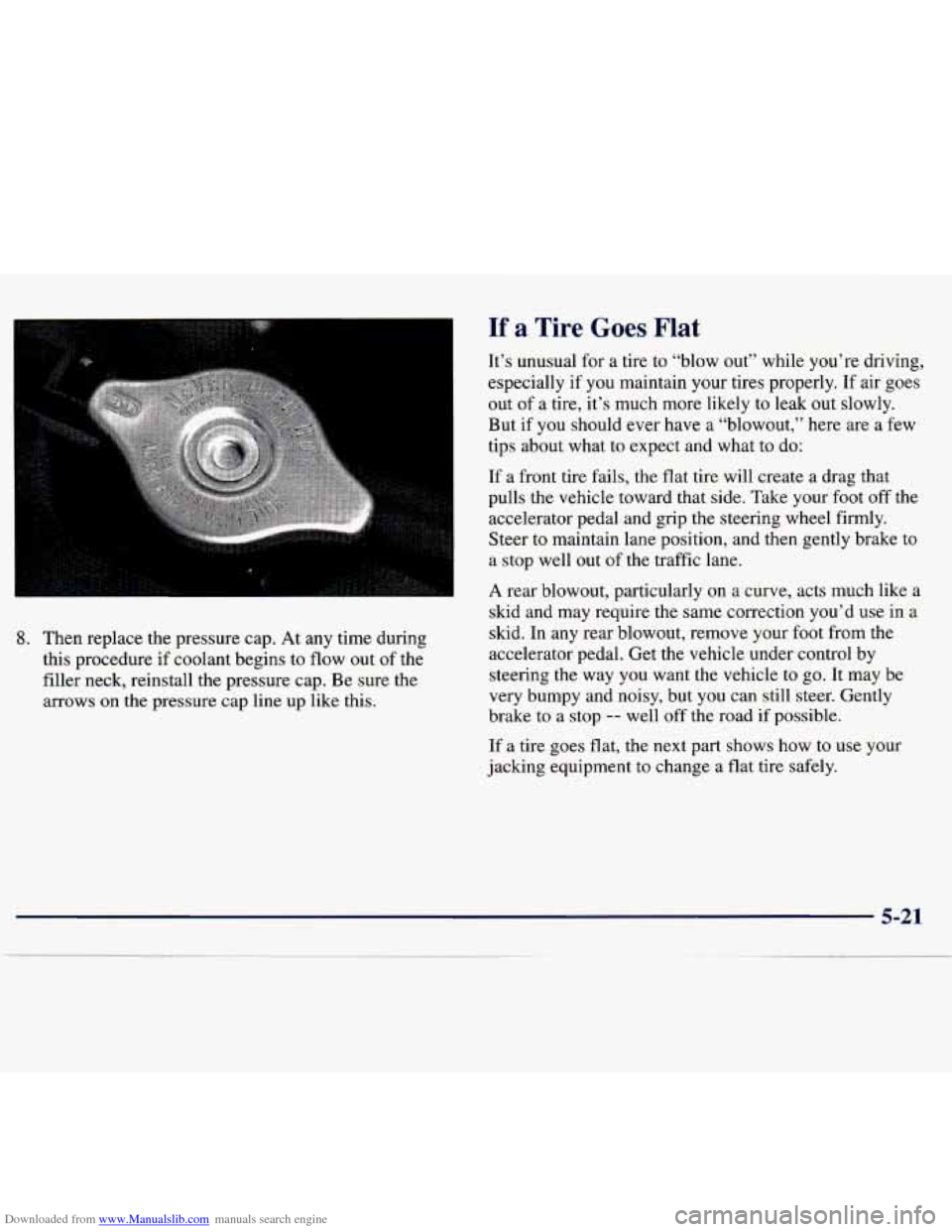
Downloaded from www.Manualslib.com manuals search engine If a Tire Goes Flat
8. Then replace the pressure cap. At any time during
this procedure if coolant begins to flow out of the
filler neck, reinstall the pressure cap. Be sure the
arrows on the pressure cap line up like this. It’s unusual
for a tire to “blow out” while you’re driving,
especially if you maintain your tires properly. If air goes
out of a tire, it’s much more likely to leak out slowly.
But if you should ever have a “blowout,” here are a few\
tips about what to expect and what to do:
If a front tire fails, the flat tire will create a drag that
pulls the vehicle toward that side. Take your foot off the
accelerator pedal and grip the steering wheel firmly.
Steer to maintain lane position, and then gently brake to
a stop well out
of the traffic lane.
A rear blowout, particularly on a curve, acts much like a
skid and may require the same correction you’d use in a
skid. In any rear blowout, remove your foot from the
accelerator pedal. Get the vehicle under control by
steering the way you want the vehicle to go. It may be
very bumpy and noisy, but you can still steer. Gently
brake to a stop
-- well off the road if possible.
If a tire goes flat, the next part shows how to
use your
jacking equipment
to change a flat tire safely.
Page 238 of 386
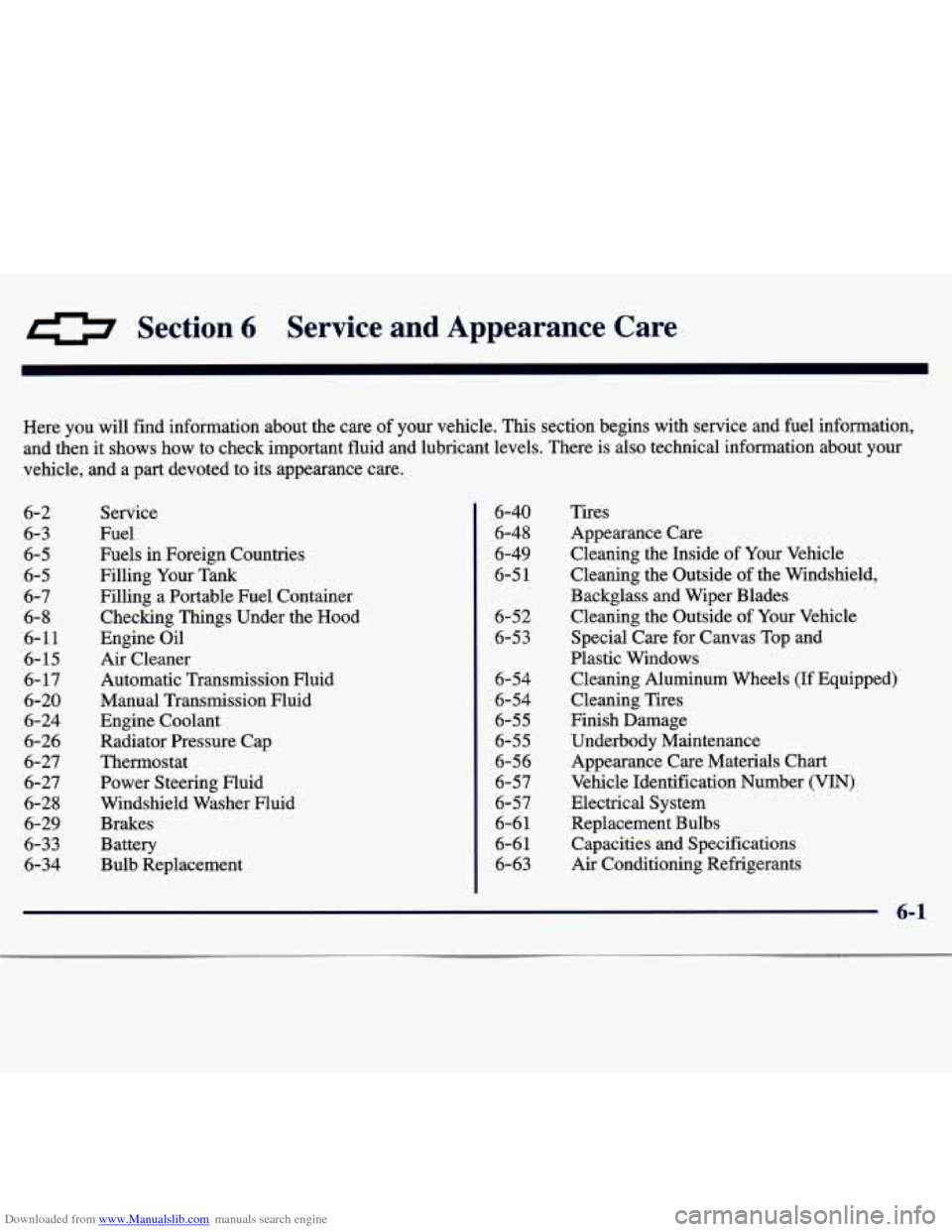
Downloaded from www.Manualslib.com manuals search engine 0 Section 6 Service and Appearance Care
Here you will find information about the care of your vehicle. This section begins with service and fuel information,
and then it shows how to check important fluid and lubricant levels. There is also technical i\
nformation about your
vehicle, and a part devoted to its appearance care.
6-2
6-3
6-5
6-5
6-7
6- 8 6-11
6-15
6-17
6-20
6-24
6-26
6-27
6-27
6-28
6-29
6-33
6-34 Service
Fuel
Fuels in Foreign Countries
Filling Your Tank
Filling a Portable Fuel Container
Checking Things Under the Hood
Engine Oil
Air Cleaner
Automatic Transmission Fluid
Manual Transmission Fluid
Engine Coolant
Radiator Pressure Cap
Thermostat
Power Steering Fluid
Windshield Washer Fluid Brakes
Battery
Bulb Replacement 6-40
6-48
6-49
6-5
1
6-52
6-53
6-54
6-54
6-55
6-55
6-56 6-57
6-57
6-61
6-6
1
6-63 Tires
Appearance Care Cleaning the Inside of Your Vehicle
Cleaning the Outside
of the Windshield,
Backglass and Wiper Blades
Cleaning the Outside of Your Vehicle
Special Care for Canvas Top and
Plastic Windows
Cleaning Aluminum Wheels
(If Equipped)
Cleaning Tires
Finish Damage
Underbody Maintenance
Appearance Care Materials Chart
Vehicle Identification Number (VIN)
Electrical System Replacement Bulbs
Capacities and Specifications
Air Conditioning Refrigerants
6-1
Page 245 of 386
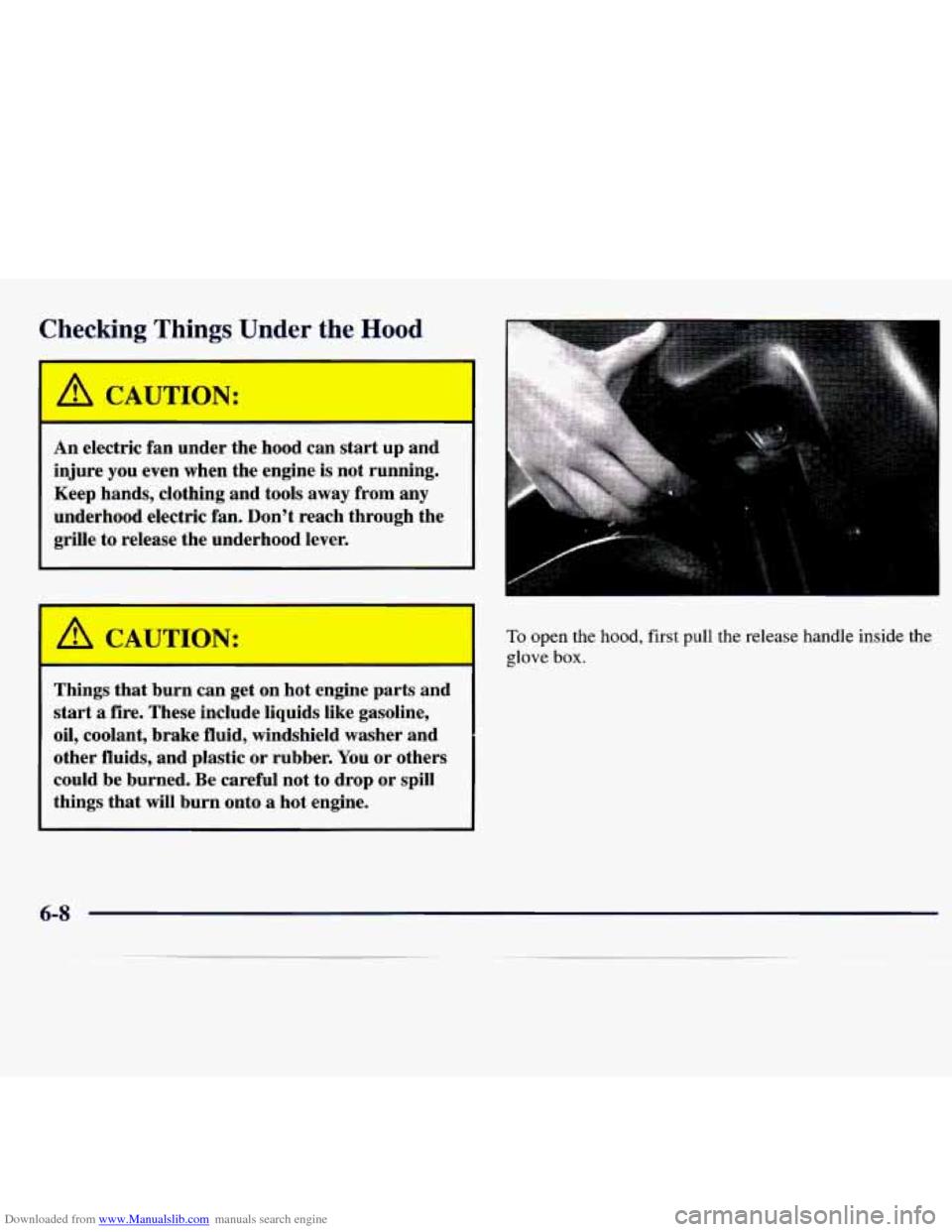
Downloaded from www.Manualslib.com manuals search engine Checking Things Under the Hood
An electric fan under the hood can start up and
injure you even when the engine is not running.
Keep hands, clothing and tools away from any
underhood electric fan. Don’t reach through the
grille
to release the underhood lever.
Things that burn can get on hot engine parts and
start a fire. These include liquids like gasoline,
oil, coolant, brake fluid, windshield washer and
other fluids, and plastic or rubber. You or others
could be burned. Be careful not to drop
or spill
things that will burn onto
a hot engine.
To open the hood, first pull the release handle inside the
glove
box.
6-8
Page 247 of 386
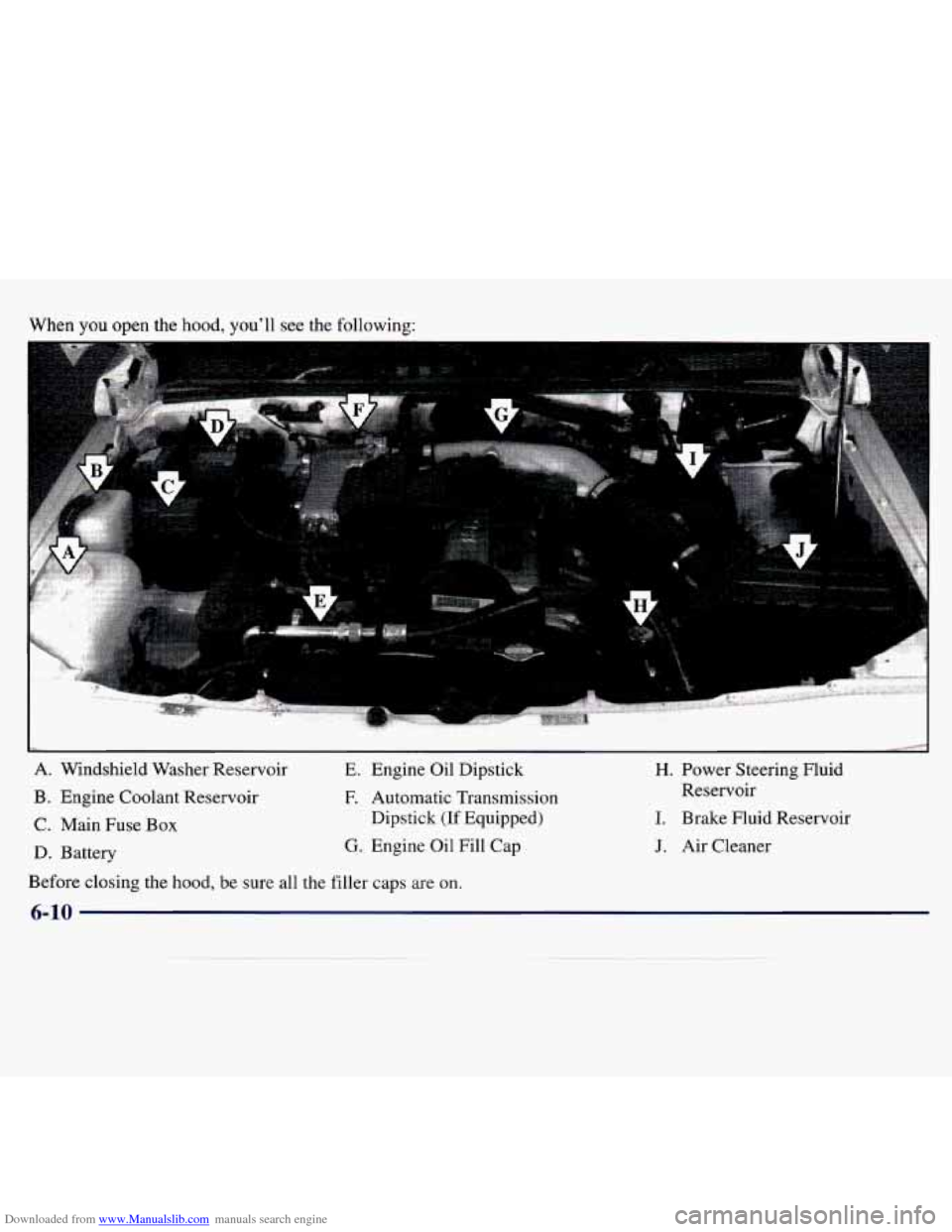
Downloaded from www.Manualslib.com manuals search engine When you open the hood, you’ll see the following:
A. Windshield Washer Reservoir
B. Engine Coolant Reservoir
C. Main Fuse
Box
D. Battery E. Engine Oil Dipstick
E Automatic Transmission
Dipstick
(If Equipped)
G. Engine Oil Fill Cap
H. Power Steering Fluid
I. Brake Fluid Reservoir
J. Air Cleaner
Reservoir
Before closing the hood, be sure all the filler caps are
on.
Page 261 of 386
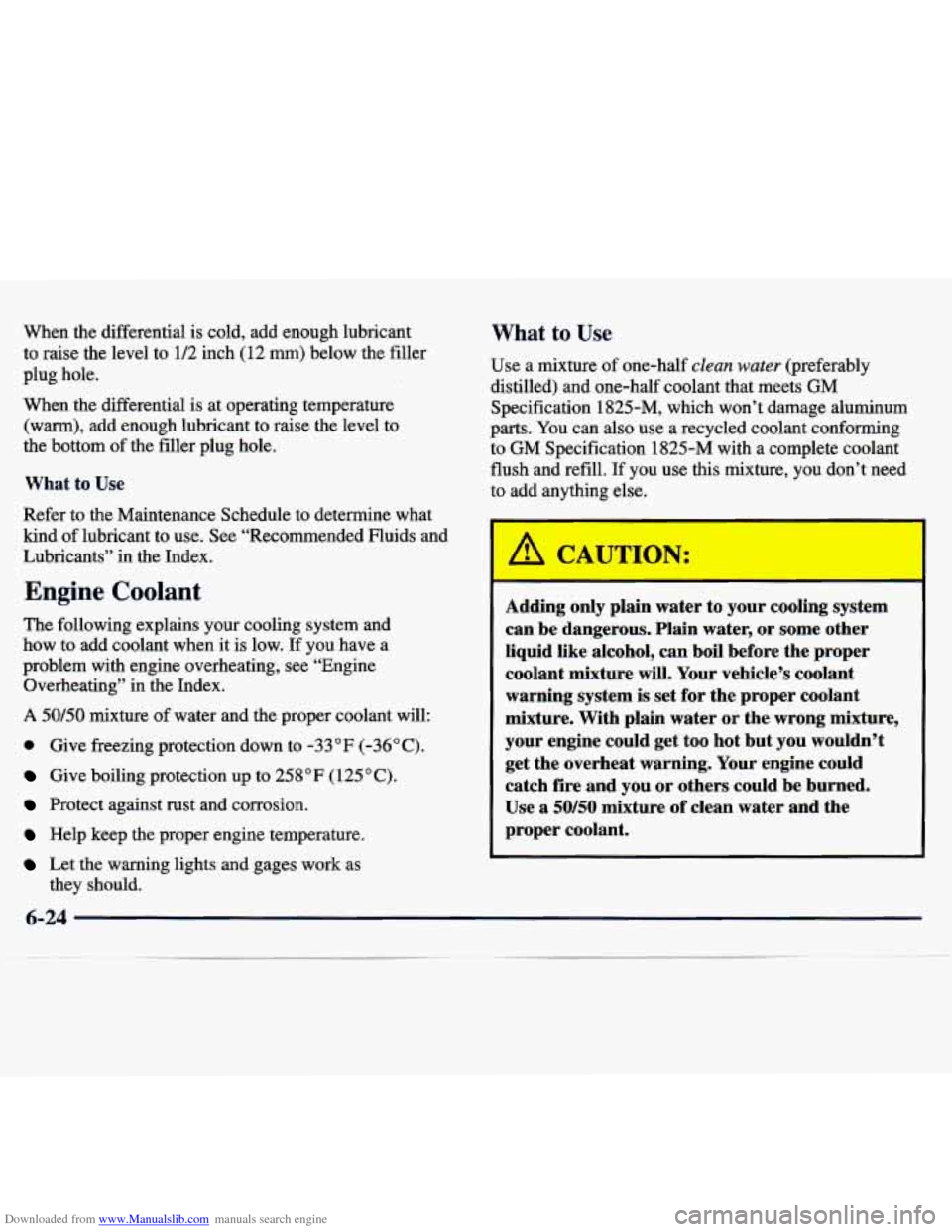
Downloaded from www.Manualslib.com manuals search engine When the differential is cold, add enough lubricant
to raise the level to 1/2 inch (12
mm) below the filler
plug hole.
When the differential is at operating temperature
(warm), add enough lubricant to raise the level to
the bottom
of the filler plug hole.
What to Use
Refer to the Maintenance Schedule to determine what
kind of lubricant to use. See “Recommended Fluids and
Lubricants” in the Index.
Engine Coolant
The following explains your cooling system and
how to add coolant when it is low. If you have a
problem with engine overheating, see “Engine
Overheating” in the Index.
A 50/50 mixture of water and the proper coolant will:
0 Give freezing protection down to -33°F (-36°C).
Give boiling protection up to 258 OF (1 25 O C).
Protect against rust and corrosion.
Help keep the proper engine temperature.
Let the warning lights and gages work as
they should.
What to Use
Use a mixture of one-half clean water (preferably
distilled) and one-half coolant that meets GM
Specification 1825-M, which won’t damage aluminum
parts.
You can also use a recycled coolant conforming
to GM Specification 1825-M with a complete coolant
flush and refill.
If you use this mixture, you don’t need
to add anything else.
Adding only plain water
to your cooling system
can be dangerous. Plain water, or some other
liquid like alcohol, can boil before the proper
coolant mixture will. Your vehicle’s coolant
warning system
is set for the proper coolant
mixture. With plain water or the wrong mixture,
your engine could get
too hot but you wouldn’t
get the overheat warning. Your engine could
catch fire and you or others could be burned.
Use a
50/50 mixture of clean water and the
proper coolant.
Page 262 of 386

Downloaded from www.Manualslib.com manuals search engine NOTICE:
If you use an improper coolant mixture, your
engine could overheat and be badly damaged.
The repair
cost wouldn’t be covered by your
warranty.
Too much water in the mixture can
freeze and crack the engine, radiator, heater core
and other parts.
If you have to add coolant more than four times
a year,
have your dealer check your cooling system.
I NOTICE:
If you use the proper coolant, you don’t have to
add extra inhibitors or additives which claim to
improve the system. These can be harmful.
Checking Coolant
When your engine is cold, the coolant level should be at
LOW, or a little higher. When your engine
is warm, the
level should be up to FULL, or
a little higher.
Adding Coolant
If you need more coolant, add the proper coolant
mixture
at the coolant recovery tank.
Page 263 of 386
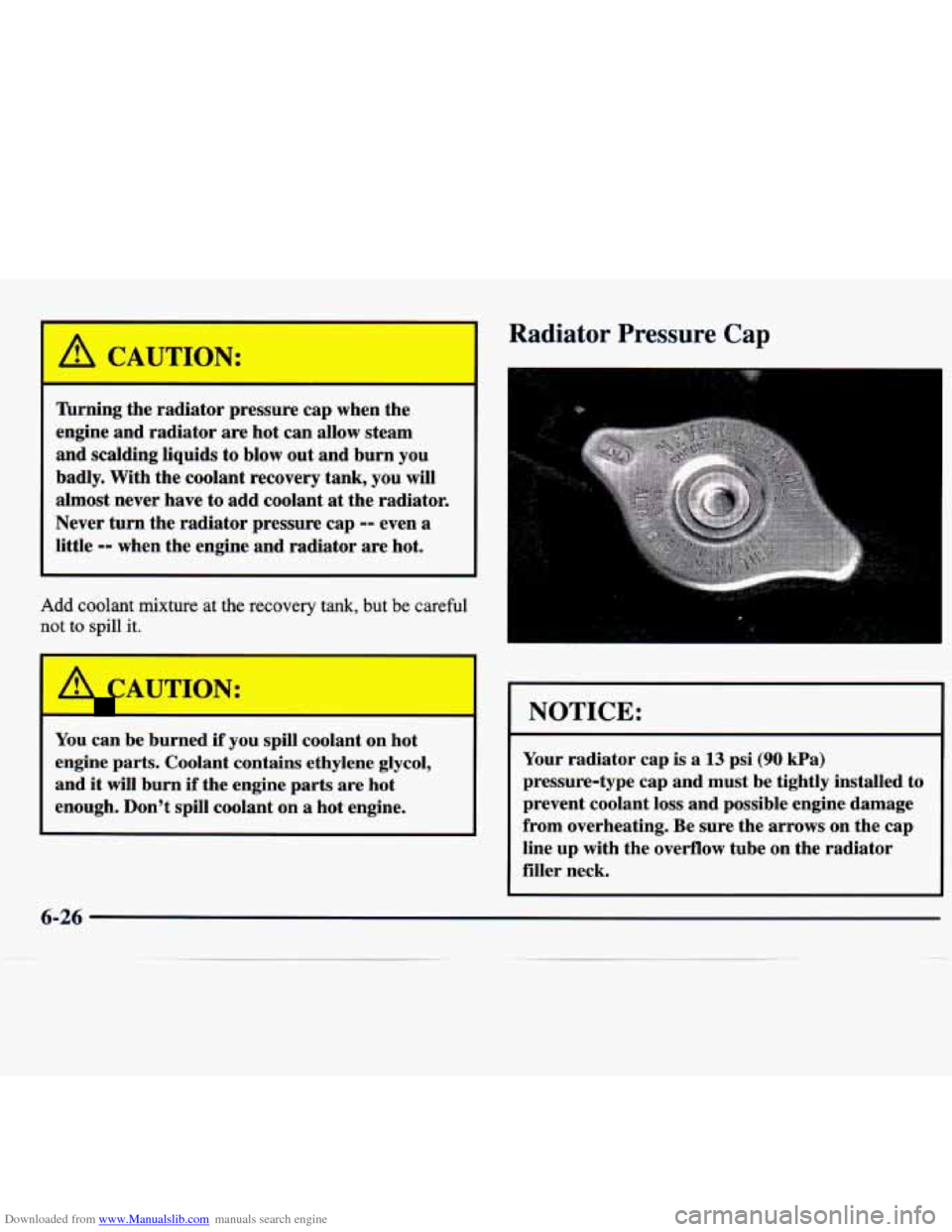
Downloaded from www.Manualslib.com manuals search engine A CAUTION:
Turning the radiator pressure cap when the
engine and radiator are hot can allow steam
and scalding liquids
to blow out and burn you
badly. With the coolant
recovery tank, you will
almost never have to add coolant
at the radiator.
Never turn the radiator pressure cap
-- even a
little -- when the engine and radiator are hot.
Add coolant mixture at the recovery tank, but be careful
not to
spill it.
You can be burned if you spill coolant on hot
engine parts. Coolant contains ethylene glycol,
and
it will burn if the engine parts are hot
enough. Don't spill coolant on
a hot engine.
Radiator Pressure Cap
*
NOTICE:
Your radiator cap is a 13 psi (90 kPa)
pressure-type cap and must be tightly installed to
prevent coolant
loss and possible engine damage
from overheating. Be sure the arrows on the cap
line up with the overflow tube on the radiator
filler neck.
6-26
Page 264 of 386

Downloaded from www.Manualslib.com manuals search engine When you replace your radiator pressure cap, an AC@
cap is recommended.
Thermostat
Engine coolant temperature is controlled by a thermostat
in the engine coolant system. The thermostat stops the
flow of coolant through the radiator until the coolant
reaches a preset temperature.
When you replace your thermostat, an AC' thermostat
is recommended.
Power Steering Fluid
When to Check Power Steering Fluid
It is not necessary to regularly check power steering
fluid unless you suspect there is a leak in the system
or
you hear an unusual noise. A fluid loss in this system
could indicate a problem. Have the system inspected
and repaired.
How To Check Power Steering Fluid
When the engine compartment is cool, wipe the cap and the top
of the reservoir clean, then unscrew the cap and
wipe the dipstick with a clean rag. Replace the cap and
completely tighten it. Then remove the cap again and
look at the fluid level on the dipstick.
When the engine compartment is hot,
the level should
be at the MAX mark.
6-27
.
Page 266 of 386
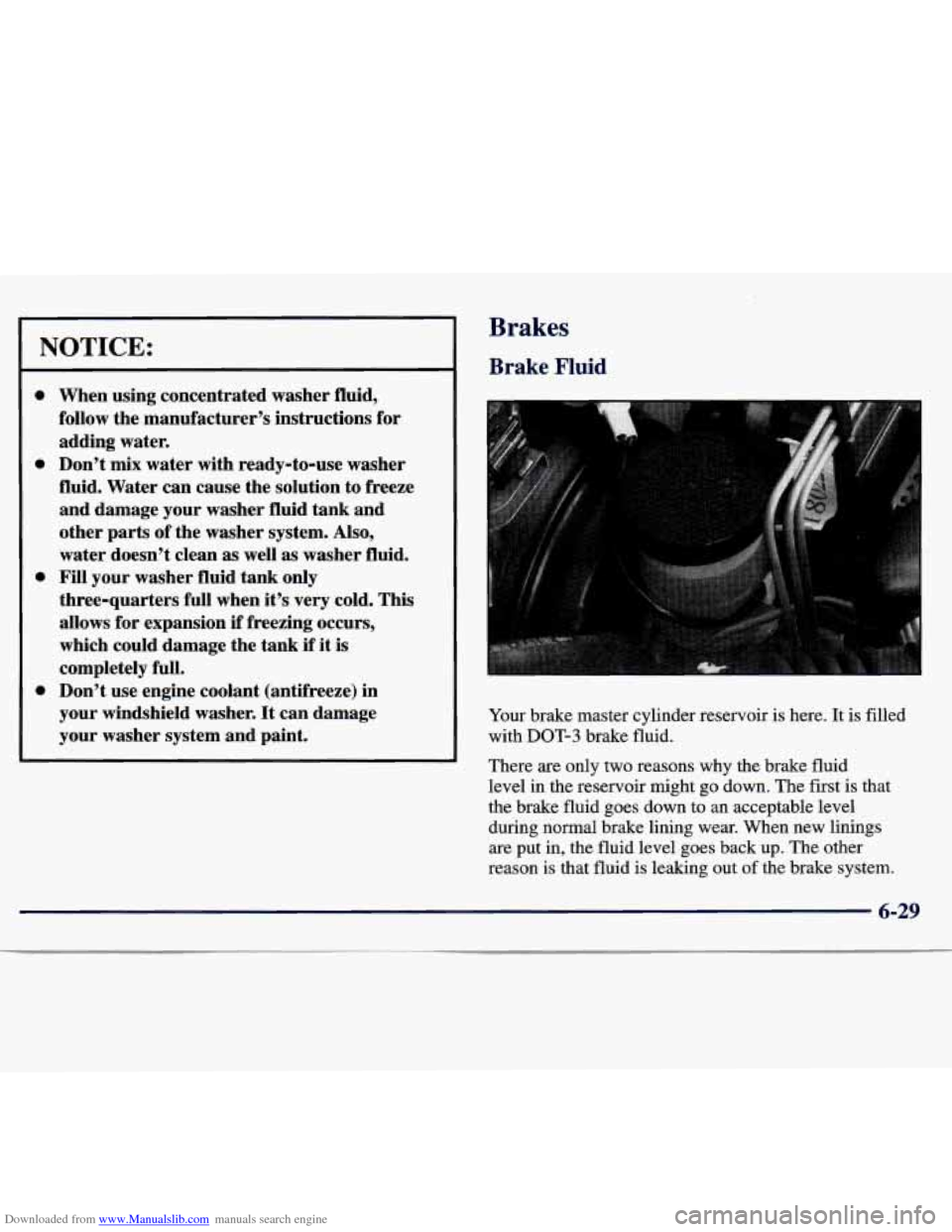
Downloaded from www.Manualslib.com manuals search engine NOTICE:
0
0
0
0
When using concentrated washer fluid,
follow the manufacturer’s instructions for
adding water.
Don’t mix water with ready-to-use wasner
fluid. Water can cause the solution to freeze and damage your washer fluid tank and
other parts of the washer system. Also,
water doesn’t clean
as well as washer fluid.
Fill your washer fluid tank only
three-quarters full when it’s very cold. This
allows for expansion
if freezing occurs,
which could damage the tank if it is
completely
full.
Don’t use engine coolant (antifreeze) in
your windshield washer. It can damage
your washer system and paint.
Brakes
Brake Fluid
Your brake master cylinder reservoir is here. It is filled
with DOT-3 brake fluid.
There are only two reasons why the brake fluid
level in the reservoir might go down. The first is that
the brake fluid goes down to an acceptable level
during normal brake lining wear. When new linings
are put in, the fluid level goes back up. The other
reason
is that fluid is leaking out of the brake system.
Page 316 of 386
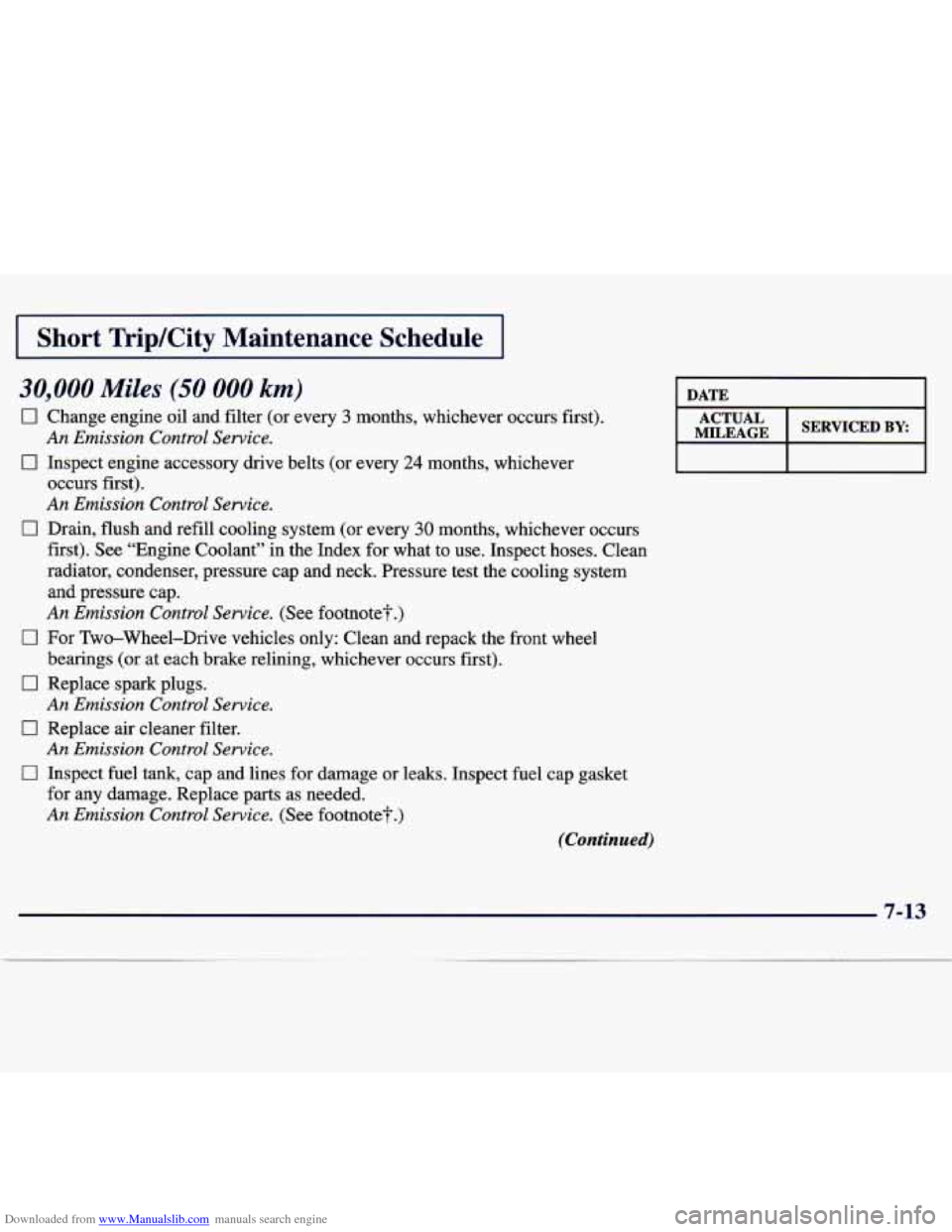
Downloaded from www.Manualslib.com manuals search engine I Short Trip/City Maintenance Schedule
30,000 Miles (50 000 km)
0 Change engine oil and filter (or every 3 months, whichever occurs first).
0 Inspect engine accessory drive belts (or every 24 months, whichever
An Emission Control Service.
occurs first).
An Emission Control Service.
0 Drain, flush and refill cooling system (or every 30 months, whichever occurs
first). See “Engine Coolant” in the Index for what to use. Inspect hoses. Clean
radiator, condenser, pressure cap and neck. Pressure test the c\
ooling system
and pressure cap.
An Emission Control Service. (See footnote?.)
bearings (or at each brake relining, whichever occurs first).
An Emission Control Service.
0 For Two-Wheel-Drive vehicles only: Clean and repack the front wheel
0 Replace spark plugs.
I DATE I
0 Replace air cleaner filter.
An Emission Control Service.
0 Inspect fuel tank, cap and lines for damage or leaks. Inspect fuel cap gasket
for any damage. Replace parts as needed.
An Emission Control Service. (See footnote?.)
(Continued)
7-13